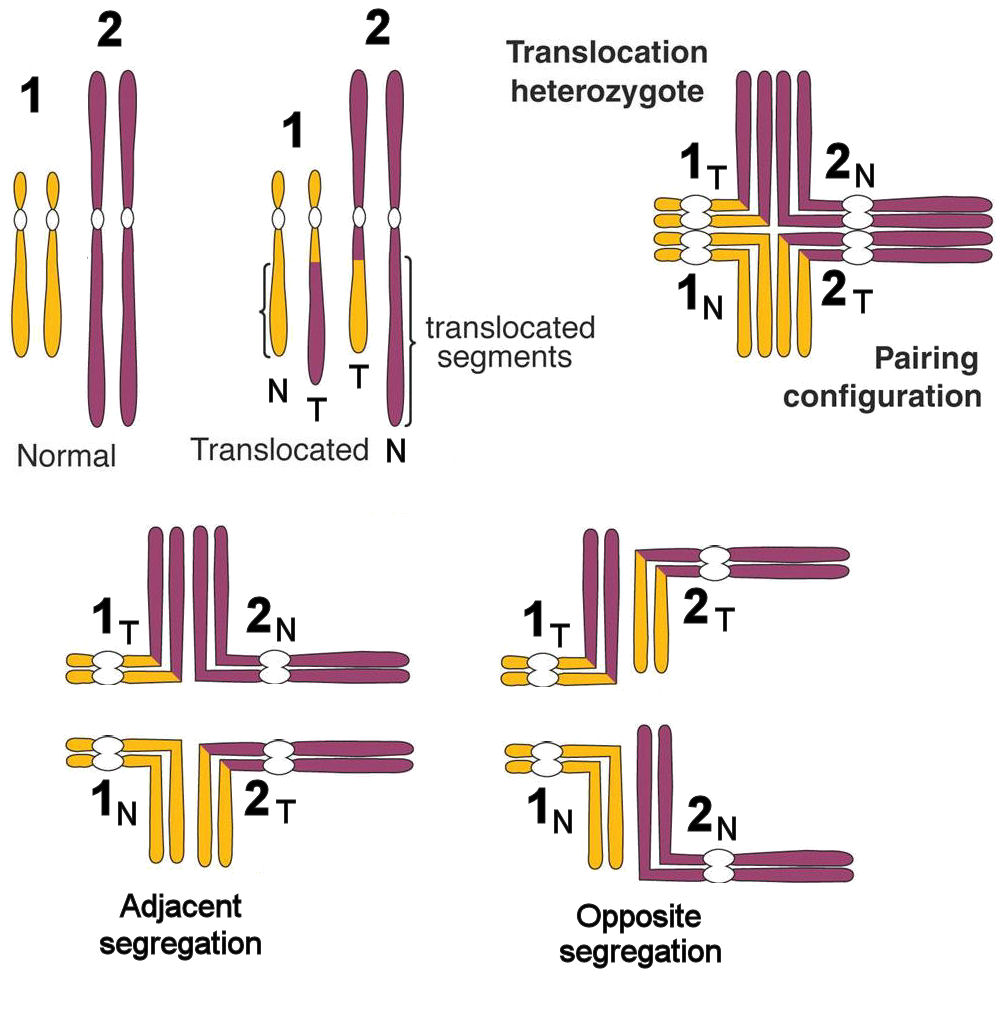
Translocation heterozygotes:
Consequences for duplication / deletion products, balanced translocations, and speciation
Consider
two chromosome pairs 1 & 2, a small acrocentric and a large metacentric,
respectively [top
left]. A reciprocal
translocation exchanges portions of their long arms
in one pair, producing
two translocated chromosomes, 1T and 2T
(top, centre). After duplication of chromatids at meiosis,
proper alignment of
the centromeres and chromosome segments requires formation of
a cross-like
pairing configuration, such that the translocated segments as
well as
the non-translocated portions align properly (top, right).
At segregation of Meiosis I, the tetrad can be segregated in either of two ways. In adjacent segregation (bottom, left), segregation of the upper and lower pairs of centromeres to opposite poles yield two duplication / deletion products, 1T 2N and 1N 2T , the first with extra bits of the long arm of Chromosome 1 and missing bits of the long arm of Chromosome 2, and the second missing parts of 1 and having extra bits of 2. These duplication / deletion gametes will produce less viable and (or) less fertile offspring, for example in the heritable form of Down Syndrome that involves a reciprocal translocation between the ends of Chromosomes 14 & 21.
In opposite segregation (bottom, right), segregation of centromeres from across the tetrad [upper left and lower right, versus lower left and upper right] produces one product with two untranslocated (normal) chromosomes (1N 2N), and another with a balanced translocation, that is, two chromosomes 1T 2T that between them include all loci on both chromosomes in their translocated arrangement.
Fertilization of a balanced translocation gamete by a normal gamete will produce a phenotypically normal individual, with meiosis complicated as above. Fertilization by another gamete with the same translocation stabilizes the chromosome rearrangement: all gametes will be viable. Balanced reciprocal translocation is thus one means of creating the novel chromosome configurations that are often seen in closely-related species. Finally, the expression of genes may be influenced by the surrounding genes, so that a translocated gene will have a different effect on the phenotype: this position effect may also be important in species differences.
At segregation of Meiosis I, the tetrad can be segregated in either of two ways. In adjacent segregation (bottom, left), segregation of the upper and lower pairs of centromeres to opposite poles yield two duplication / deletion products, 1T 2N and 1N 2T , the first with extra bits of the long arm of Chromosome 1 and missing bits of the long arm of Chromosome 2, and the second missing parts of 1 and having extra bits of 2. These duplication / deletion gametes will produce less viable and (or) less fertile offspring, for example in the heritable form of Down Syndrome that involves a reciprocal translocation between the ends of Chromosomes 14 & 21.
In opposite segregation (bottom, right), segregation of centromeres from across the tetrad [upper left and lower right, versus lower left and upper right] produces one product with two untranslocated (normal) chromosomes (1N 2N), and another with a balanced translocation, that is, two chromosomes 1T 2T that between them include all loci on both chromosomes in their translocated arrangement.
Fertilization of a balanced translocation gamete by a normal gamete will produce a phenotypically normal individual, with meiosis complicated as above. Fertilization by another gamete with the same translocation stabilizes the chromosome rearrangement: all gametes will be viable. Balanced reciprocal translocation is thus one means of creating the novel chromosome configurations that are often seen in closely-related species. Finally, the expression of genes may be influenced by the surrounding genes, so that a translocated gene will have a different effect on the phenotype: this position effect may also be important in species differences.